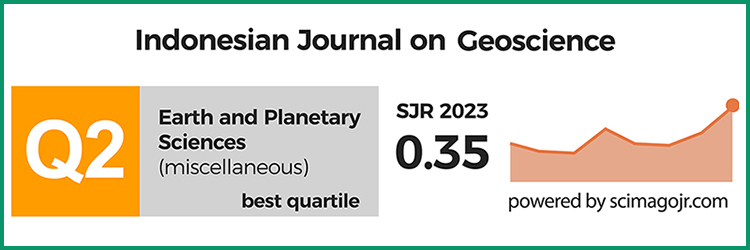Hydrothermal system of the Papandayan Volcano, West Java, Indonesia and its geochemistry evolution of thermal water after the November 2002 eruption
DOI:
https://doi.org/10.17014/ijog.2.1.15-29Keywords:
Papandayan Volcano, phreatic eruption, hydrothermal system, fluid geochemistry, advanced argillic alterationAbstract
https://dx.doi.org/10.17014/ijog.vol2no1.20072
Papandayan is a strato volcano situated in West Java, Indonesia. After the last magmatic eruptionin 1772, only few phreatic explosions have been occurring. At the present time, the activity is centeredin the northeast crater manifested by the presence of fumaroles and hot springs. In November 2002an explosive eruption occurred and ejected ash and altered rocks. Study of the altered rocks revealedthat an advanced argillic alteration took place in the hydrothermal system by an interaction betweenacid fl uids and rocks. Four zones of alteration have been formed as a limited extension along faults oracross permeable structures at different levels beneath the active crater of the volcano.
Two types of acid fl uids are distinguished in the crater of the Papandayan Volcano: (1) acidsulphate-chloride water with pH values between 1.6 and 4.6, and (2) acid sulphate water with pHvalues between 1.2 and 2.5. The samples collected after the eruption revealed an increase in the SO4/Cl and Mg / Cl ratios. This evolution is likely explained by an increase in the neutralization of acidfl uids which tends to show that water-rock interactions were more signifi cant after the eruption. Thechanges in chemistry observed in 2003 were the consequence of the opening of new fractures whereunaltered or less altered volcanic rocks were in contact with the ascending acid water. The high δ34Svalues (9-17‰) observed in the acid sulphate-chloride water before the November 2002 eruptionsuggest that dissolved sulphates were mainly formed by the disproportionation of magmatic SO2. Onthe other hand, the low δ34S values (-0.3-7 ‰) observed in acid sulphate-chloride water sampled afterthe eruption suggest that the origin of dissolved sulphates for these waters is the surfi cial oxidation ofhydrogen sulphide.
References
Arribas, A.J., 1995. Geology, geochronology, fluid inclusions, and isotope geochemistry of the Rodalquilar gold alunite deposit, Spain. Economic Geology, 90, p. 795-822.
Ball, J.W. and Nordstrom, D.K., 1991. WATEQ4f-User’s manual with revised thermodynamic database and test cases for calculating speciation of major, trace and redox elements in natural waters. U.S. Geological Survey Open- File Report, 90-129:185p.
Bernard, A., Escobar, C.D., Mazot, A., and Guttierres, R.E., 2004. The acid crater lake of Santa Ana volcano, El Salvador. Geological Society of America Special Paper, 375, p. 121-133.
Christenson, B. and Wood, C.P., 1993. Evolution of a vent-hosted hydrothermal system beneath Ruapehu Crater Lake, New Zealand. Bulletin of Volcanology, 55, p. 547-565.
Delmelle, P. and Bernard, A., 1994. Geochemistry, mineralogy, and chemical modeling of the acid crater lake of Kawah Ijen Volcano, Indonesia. Geochemica et Cosmochimica Acta, 58(11), p. 2445-2460.
Federico, C., 2002. Magma-derived gas influx and water-rock interactions in the volcanic aquifer of Mt. Vesuvius, Italy. Geochemica et Cosmochimica Acta, 66(6), p. 963-981.
Fischer, T.P., 1997. The chemical and isotopic composition of fumarolic gases and spring discharges from Galeras Volcano, Colombia. Journal of Volcanology and Geothermal Research, 77, p. 229-253.
Giggenbach, W.F., 1974. The chemistry of Crater Lake, Mt Ruapehu (New Zealand) during and after the 1971 active period. New Zealand Journal of Science, 17, p. 33-45.
Giggenbach, W.F., 1992. Magma degassing and mineral deposition in hydrothermal systems along convergent plate boundaries. Economic Geology, 87, p. 1927- 1944.
Giggenbach, W.F., 1996. Chemical composition of volcanic gases. In: Scarpa, R.W. and Tilling, R.I. (Editors), Monitoring and Mitigation of Volcano Hazards, Berlin, p. 221-256.
Giggenbach, W.F., García, N. Londoño, A. Rodríguez, L. Rojas, N., and Calvache, M.L., 1990. The chemistry of fumarolic vapor and thermal-spring discharges from the Nevado del Ruiz volcanic-magmatic-hydrothermal system, Colombia. Journal of Volcanology and Geothermal Research, 42, p. 13.
Giggenbach, W.F., Tedesco, D., Sulistiyo, Y., Caprai, A., Cioni, R., Favara, R., Fischer, T.P., Hirabayashi, J.- I., Korzhinsky, M., Martini, M., Menyailovk, I., and Shinohara, H., 2001. Evaluation of results from the fourth and fifth IAVCEI field workshops on volcanic gases, Vulcano island, Italy and Java, Indonesia. Journal of Volcanology and Geothermal Research, 108, p. 157- 172.
Hedenquist, J.W., Arribas, A.J., and Reynolds, T.J., 1998. Evolution of an intrusion-centered hydrothermal system: Far Southeast-Lepanto porphyry and epithermal Cu- Au deposits, Philippines. Economic Geology, 93(4): 373-404.
Hedenquist, J.W., 1994. Geology, geochemistry, and origin of high sulfidation Cu-Au mineralization in the Nansatsu District, Japan. Economic Geology, 89(1), p. 1-30.
Hemley, J.J., Montoya, J.W., Marinenko, J.W., and Luce, R.W., 1980. Equilibria in the system Al O -SiO -H O an some general implications for alteration/ mineralization processes. Economic Geology, 75, p. 210-228.
Johnson, J.W., Oelkers, E.H., and Helgeson, H.C., 1992. SUPCRT92: a software package for calculating the standard molal thermodynamic properties of minerals, gases, aqueous species, and reactions from 1 to 5000 bar and 0 to 1000°C. Computers & Geosciences, 18(7), p. 899-947.
Kiyosu, Y. and Kurahashi, M., 1983. Origin of sulfur species in acid sulphate-chloride thermal waters, northeastern Japan. Geochemica et Cosmochimica Acta, 47, p. 1237- 1245.
Kusakabe, M. and Komoda, Y., 1992. Sulfur isotopic effects in the disproportionation reaction of sulfur dioxide at hydrothermal temperatures. Report, Geological Survey of Japan, 279, p. 93-96.
Kusakabe, M., Komoda, Y., Takano, B., and Abiko, T., 2000. Sulfur isotopic effects in the disproportionation reaction of sulfur dioxide in hydrothermal fluids: implications for the δ34S variations of dissolved bisulfate and elemental sulfur from active crater lakes. Journal of Volcanology and Geothermal Research, 97, p. 287-307.
Marumo, K., 1989. Genesis of kaolin minerals and pyrophyllite in Kuroko deposits of Japan: implications for the origins of the hydrothermal fluids from mineralogical and stable isotope data. Geochemica et Cosmochimica Acta, 53, p. 2915-2924.
Murowchick, J.B. and Barnes, H.L., 1986. Marcasite precipitation from hydrothermal solutions. Geochemica et Cosmochimica Acta, 50, p. 2615-2629.
Nicholson, K., 1993. Geothermal fl uids: Chemistry and Exploration Techniques. Springer-Verlag, Berlin, 268 pp.
Nogami, K., Hirabayashi, J.-I., Ohba, T., and Yoshiike, Y., 2000. The 1997 phreatic eruption of Akita-Yakeyama volcano, northeast Japan: Insight into the hydrothermal processes. Earth Planets Space, 52, p. 229-236.
Ohba, T., Hirabayashi, J.-I. and Nogami, K., 1994. Water, heat and chloride budgets of the crater lake, Yugama at Kusatsu-Shirane volcano, Japan. Geochemical Journal, 28, p. 217-231.
Ohmoto, H. and Goldhaber, M.B., 1997. Sulfur and carbon isotopes. In: H.L. Barnes (Editor), Geochemistry of hydrothermal ore deposits (third edition). Wiley &Sons, New York, p. 517-611.
Ohsawa, S., Takano, B., Kusakabe, M. and Watanuki, K., 1993. Variation in volcanic activity of Kusatsu-Shirane volcano as inferred from δ34S in sulfate from the Yugama crater lake. Bulletin of the Volcanological Society of Japan, 38, p. 95.
Parkhurst, D.L. and Appelo, C.A.J., 1999. User’s guide to PHREEQC-- A computer program for speciation, batch-reaction, one-dimensional transport, and inverse geochemical calculations. U.S. Geological Survey Water- Resources Investigations Report, 99-4259: 312 p.
Pasternack, G.B. and Varekamp, J.C., 1994. The geochemistry of Keli Mutu volcanic lakes Flores, Indonesia. Geochemica et Cosmochimica Acta, 28, p. 243-262.
Reed, M.H. and Spycher, N.F., 1985. Boiling, cooling and oxidation in epithermal systems : A numerical modeling approach. Geology and Geochemistry of epithermal systems, p. 249-272.
Reyes, A.G., 1990. Petrology of Philippine geothermal systems and the application of alteration mineralogy to their assessment. Journal of Volcanology and Geothermal Research, 43, p. 279-309.
Schoonen, M.A.A. and Barnes, H.L., 1991. Mechanisms of pyrite and marcasite formation from solution:III. Hydrothermal processes. Geochemica et Cosmochimica Acta, 55, p. 3491-3504.
Stoffregen, R., 1987. Genesis of acid-sulfate alteration and Au-Cu-Ag mineralization at Summitville, Colorado. Economic Geology, 82, p. 1575-1591.
Stoffregen, R., Alpers, C.N., and Jambor, J.L., 2000. Alunite-Jarosite Crisatllography, Thermodynamics, and Geochronology. In: Alpers, C.N., Jambor, J.L., and Nordstrom, D.K. (Editors), Sulfate minerals- Crystallography, Geochemistry, and Environmental Significance. Reviews in Mineralogy & Geochemistry. The Mineralogical Society of America, Washington, p. 453-480.
Takano, B. and Watanuki, K., 1990. Monitoring of volcanic eruptions at Yugama crater lake by aqueous sulfur oxyanions. Journal of Volcanology and Geothermal Research, 40, p. 71-87.
Taran, Y., 1998. Geochemistry of the volcano-hydrothermal system of El Chichon Volcano, Chiapas, Mexico. Bulletin of Volcanology, 59, p. 436-449.
Taran, Y., Pokrovsky, B., and Dubik, Y.M., 1989. Isotopic composition and origin of water from andesitic magmas. Doklady (Translations) Academy of Science USSR, 304, p. 401-404.
Taran, Y.A., Hedenquist, J.W., Korzhinsky, M.A., Tkachenko, S.I., and Shmulovich, K.I., 1995. Geochemistry of magmatic gases from Kudryavy volcano, Iturup, Kuril Islands. Geochemica et Cosmochimica Acta, 59(9), p. 1749-1761.
Tassi, F., 2003. Chemical composition of fumarolic gases and spring discharges from El Chichon volcano, Mexico: causes and implications of the changes detected over the period 1998-2000. Journal of Volcanology and Geothermal Research, 123, p. 105-121.
USGS, 1998. Bulletin of Global Volcanism Network, 23:07: https://volcano.si.edu/reports/usgs.
USGS, 2002. Bulletin of Global Volcanism Network, 27:11: https://volcano.si.edu/reports/usgs.
USGS, 2003. Bulletin of Global Volcanism Network, 28:07: https://volcano.si.edu/reports/usgs.
Valentino, G.M., Cortecci, G., Franco, E., and Stanzione, D., 1999. Chemical and isotopic compositions of minerals and waters from the Campi Flegrei volcanic system, Naples, Italy. Journal of Volcanology and Geothermal Research, 91, p. 329-344.
van Padang, N.M., 1951. Indonesia. Catalogue of the Active Volcanoes of the World,Rome: IAVCEI, 1, p. 1-271.
Varekamp, J.C. and Kreulen, R., 2000. The stable isotope geochemistry of volcanic lakes, with examples from Indonesia. Journal of Volcanology and Geothermal Research, 97, p. 309-327.
Yilmaz, H., 2003. Exploration at the Kuscaryiri Au (Cu) prospect and its implications 3 for porphyry- related mineralization in western Turkey. Journal of Geochemical Exploration, 77, p. 133-150.



















